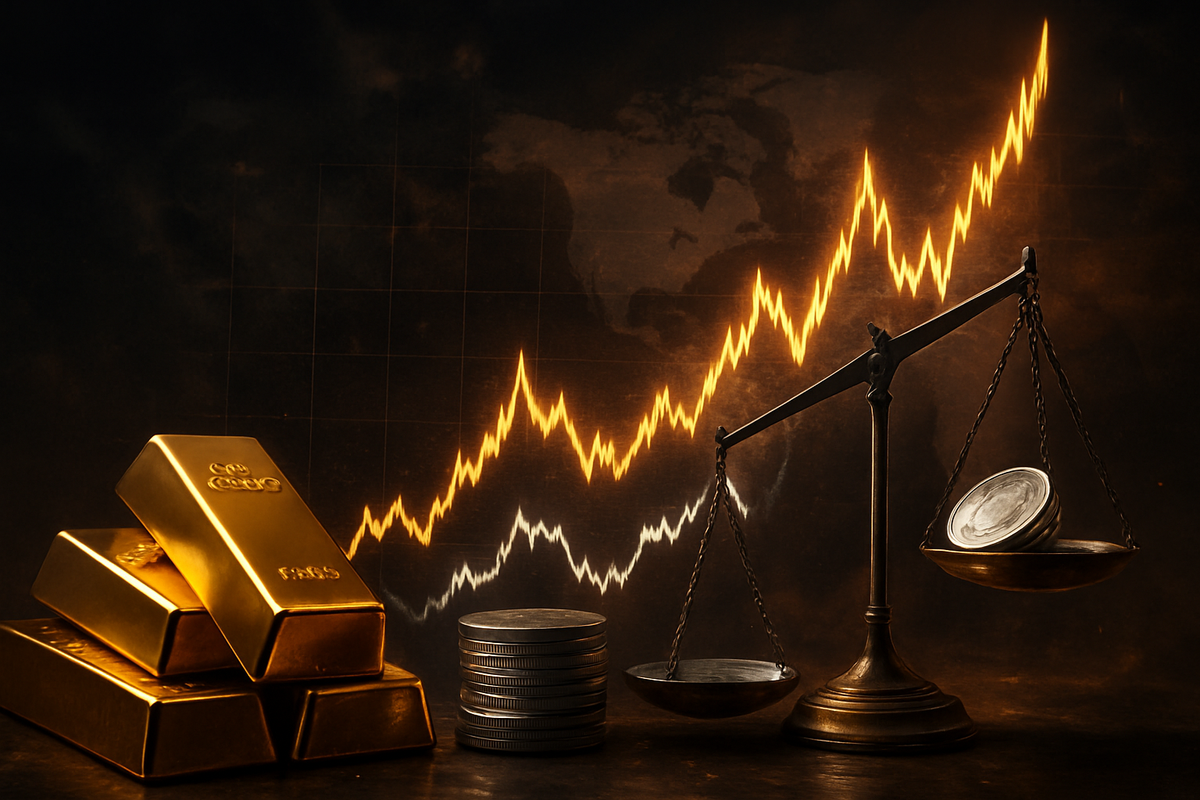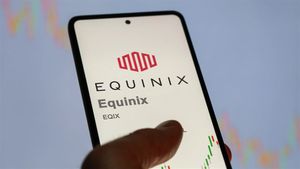
October 2025 delivered a truly historic and tumultuous ride for precious metals investors, as both gold and silver surged to unprecedented record highs before experiencing sharp, volatile corrections. This month-long saga saw gold briefly touch nearly $4,400 per ounce and silver shatter its 1980 record, soaring past $54 per ounce, driven by a confluence of escalating geopolitical tensions, aggressive central bank easing, and robust industrial demand. The dramatic swings underscore a rapidly evolving financial landscape where safe-haven assets are increasingly sought after, yet remain susceptible to swift shifts in market sentiment and profit-taking.
The immediate implications of this volatility are profound, signaling a period of heightened uncertainty for global markets. While the initial surge reflected deep-seated concerns about inflation and economic stability, the subsequent pullbacks highlight the inherent risks of speculative fervor. Investors are now grappling with how to interpret these movements: are they a sign of a sustained bullish trend with healthy corrections, or a precursor to further instability? The answer will likely shape investment strategies across commodities, equities, and currencies in the months to come.
A Month of Unprecedented Gains and Dramatic Reversals
October 2025 kicked off with an almost euphoric ascent for precious metals. Gold (XAU) began the month with significant momentum, pushing past the $4,350 per ounce mark and ultimately establishing a new all-time high of approximately $4,381.58 on October 20. The London market mirrored this strength, with prices comfortably exceeding $4,000. This rally propelled gold's year-to-date gains to an impressive 50-55%, reflecting a sustained flight to safety amidst global anxieties.
Silver (XAG) outshone even gold in its initial explosive rally. On October 8, spot silver climbed by as much as 3.4%, reaching $49.55 per ounce and decisively breaking its 1980 record high. The white metal continued its meteoric rise, ultimately touching an all-time high of $54.49 per troy ounce. In India, a significant market for silver, prices soared past ₹1.89 lakh per kilogram in major cities, even hitting ₹2 lakh in Chennai, Hyderabad, and Kerala by October 17, with the MCX Silver futures contract robustly trading around ₹1,60,000.
However, the latter half of October brought a stark reversal. Gold experienced a sharp decline on October 21, falling nearly 6% from its peak. This was followed by its steepest intraday drop in over 12 years on October 22, plunging by up to 6.3%. By month-end, gold had corrected from its near-$4,400 peak to stabilize around $4,137, representing a 6-7% pullback. Silver faced an even more dramatic correction, plunging over 6% in a single session on October 17, and then falling more than 10% from highs above $54 to the $48-49 range in just days. Despite these corrections, silver managed to extend its weekly gains by over 3% to close the month around $48.77 per ounce.
The underlying factors driving these wild swings were multifaceted. Persistent global inflation, exacerbated by ongoing conflicts in Ukraine and the Middle East, escalating trade tensions, and a surge in global debt, fueled the initial safe-haven demand. Crucially, the Federal Reserve's aggressive monetary easing, with interest rates brought into the 3.75%-4.00% range, significantly reduced the opportunity cost of holding non-yielding assets. Central banks globally, particularly in emerging markets, engaged in record-breaking gold accumulation, with India's Reserve Bank adding around 100 tons and China's central bank purchasing 80 tons in the first three quarters of 2025 as part of de-dollarization strategies. A weakening U.S. Dollar Index (DXY), which fell nearly 11% in the first half of 2025, further bolstered the appeal of dollar-denominated precious metals. For silver, strong industrial demand from sectors like solar, electric vehicles (EVs), and electronics, coupled with persistent supply deficits, provided additional tailwinds. Initial market reactions were characterized by a rush to buy, with images of queues outside bullion dealers and surging ETF inflows. However, the corrections were largely attributed to widespread profit-taking, a shift in overall risk sentiment, and technical selling after both metals entered "overbought" territory.
Navigating the Volatility: Winners and Losers in the Precious Metals Market
The extreme volatility in gold and silver prices during October 2025 presents a mixed bag for public companies across various sectors. Mining companies, particularly those with significant exposure to gold and silver production, are at the forefront of this impact.
Potential Winners: Major gold mining companies such as Barrick Gold Corp. (NYSE: GOLD), Newmont Corp. (NYSE: NEM), and Agnico Eagle Mines Ltd. (NYSE: AEM) likely saw their revenues and profitability prospects significantly boosted during the peak price periods. Higher metal prices directly translate to increased revenue per ounce extracted, potentially expanding profit margins, especially for mines with lower operating costs. Similarly, silver producers like Pan American Silver Corp. (NASDAQ: PAAS) and Hecla Mining Company (NYSE: HL) would have benefited immensely from silver's meteoric rise. These companies could leverage the higher prices to pay down debt, invest in exploration, or return capital to shareholders. Furthermore, companies involved in the refining, storage, and trading of precious metals, such as specialized commodity traders and vault operators, may have seen increased activity and demand for their services during this period of heightened interest and price movement.
Potential Losers (or those facing challenges): While high prices are generally good for producers, the sharp corrections introduce significant volatility risk. Companies that hedged their production at lower prices might miss out on the full upside, while those with unhedged positions face the risk of substantial mark-to-market losses during sharp downturns. Junior exploration companies, which rely heavily on investor sentiment and capital markets for funding, could find it harder to raise capital if the market perceives precious metals as too volatile or enters a sustained correction. Moreover, industries that heavily rely on silver as an industrial input, such as solar panel manufacturers, electric vehicle battery producers, and electronics companies, might face increased input costs. While the long-term industrial demand for silver remains strong, sudden price spikes could squeeze margins for companies like First Solar Inc. (NASDAQ: FSLR) or various EV component suppliers if they cannot pass on these costs to consumers or find alternative materials. Jewelry retailers and manufacturers could also see a temporary dip in demand during extreme price volatility as consumers postpone purchases, although the cultural significance of gold and silver in many regions, particularly during festivals like Diwali, can mitigate some of this impact.
Overall, the October market performance underscores the importance of robust risk management strategies for companies in the precious metals ecosystem. Those with strong balance sheets, efficient operations, and prudent hedging policies are better positioned to capitalize on the upside while mitigating the risks associated with extreme price swings.
Broader Implications: A Barometer of Global Unease and Shifting Economic Tides
The October 2025 performance of gold and silver transcends mere commodity price movements; it serves as a potent barometer of deeper global economic and geopolitical anxieties. This event fits squarely into a broader trend of increasing demand for safe-haven assets driven by persistent global inflation, geopolitical instability, and central bank policies. The record highs signal a pervasive lack of confidence in traditional financial instruments and fiat currencies, prompting investors and central banks alike to seek tangible stores of value.
The ripple effects of this volatility extend across various markets. Competitors in the investment space, such as bond markets, may find themselves less attractive as investors prioritize inflation hedges. Partners in the industrial sector, particularly those reliant on silver, are forced to re-evaluate supply chain strategies and cost structures. The significant central bank gold accumulation, especially from nations like China and India, reflects a deliberate de-dollarization strategy and a diversification away from U.S. dollar-denominated assets. This trend could have long-term implications for the U.S. dollar's global reserve status and international trade dynamics.
Regulatory bodies and policymakers will undoubtedly scrutinize the extreme price swings. Concerns about market manipulation, excessive speculation, and the stability of commodity markets could lead to calls for increased oversight or new regulations, particularly if volatility continues. The U.S. government shutdown, which halted key data releases during October, further highlighted the fragility of market information and its potential to exacerbate uncertainty, a factor that regulators might address.
Historically, periods of significant precious metals rallies have often coincided with major economic crises or geopolitical upheavals. The 1970s oil shocks, the 2008 financial crisis, and various periods of high inflation all saw gold and silver surge. The current environment, characterized by ongoing conflicts, trade tensions, and unprecedented levels of global debt, draws parallels to these historical precedents, suggesting that the underlying drivers of the October rally are deeply rooted systemic issues rather than transient phenomena. The subsequent corrections, however, are also historically consistent, as markets tend to correct after rapid, speculative surges, unwinding overbought conditions and prompting profit-taking.
The Road Ahead: Navigating Continued Volatility and Emerging Opportunities
Looking ahead, the precious metals market is likely to remain highly dynamic, with continued volatility in the short term. The sharp corrections observed in late October suggest that while the underlying bullish drivers for gold and silver remain strong, the path forward will not be a straight line. Investors should anticipate further price swings as markets digest ongoing geopolitical developments, central bank communications, and incoming economic data.
In the short term, the key factors to watch include the trajectory of global inflation, any further escalation or de-escalation of conflicts in Ukraine and the Middle East, and the Federal Reserve's future monetary policy decisions. While the Fed has been easing, any hints of a pause or reversal in rate cuts could trigger further profit-taking in precious metals. The resolution of U.S.-China trade tensions, which contributed to the late-October pullback, will also be critical. If a more comprehensive trade agreement is reached, safe-haven demand could temporarily recede.
Long-term possibilities, however, appear more favorable for precious metals. The structural drivers of demand, such as central bank diversification, persistent inflation concerns, and robust industrial applications for silver (especially in green technologies), are expected to provide sustained support. This could lead to a new, higher baseline for gold and silver prices, even if short-term corrections occur.
Potential strategic pivots for investors and companies include strengthening portfolios with a strategic allocation to precious metals as a hedge against systemic risk and inflation. Mining companies might focus on optimizing operational efficiencies to maintain profitability across price cycles and explore strategic acquisitions to expand reserves. Market opportunities could emerge during dips, offering "buy the dip" opportunities for long-term investors looking to capitalize on the underlying bullish trend. Challenges will include managing heightened price risk, navigating potential regulatory changes, and forecasting shifts in global economic sentiment. Potential scenarios range from a continued, albeit volatile, ascent towards new highs, to a more prolonged consolidation phase before the next leg up, depending on the evolution of global macro factors.
October's Legacy: A Testament to Resilience and a Call for Prudence
October 2025 will be remembered as a landmark month for gold and silver, a period that showcased both the incredible upside potential and the inherent volatility of precious metals. The record-setting rallies underscored their enduring role as safe-haven assets in an uncertain world, driven by a powerful cocktail of geopolitical instability, inflationary pressures, and strategic central bank buying. The subsequent, equally dramatic corrections served as a stark reminder that even in a bullish market, profit-taking and shifts in sentiment can trigger swift and significant price adjustments.
Moving forward, the market is poised for continued vigilance. While the underlying fundamentals supporting precious metals remain robust – from persistent global debt and inflation fears to the ongoing de-dollarization efforts by central banks and the burgeoning industrial demand for silver – investors must exercise prudence. The "healthy correction" narrative adopted by many analysts suggests that these metals have reset from overbought conditions, potentially paving the way for more sustainable growth.
The lasting impact of October's events is likely to be a reinforced understanding of precious metals as a crucial component of a diversified portfolio, particularly in an era defined by economic and political flux. It also highlights the growing influence of central bank policies and geopolitical events on commodity markets. Investors should closely watch for further developments in global trade relations, the pace and scope of central bank monetary policies, and any escalation or de-escalation of international conflicts. These factors will be instrumental in shaping the next chapter for gold and silver, determining whether October's records are merely stepping stones to even greater heights or a cautionary tale of speculative excess.
This content is intended for informational purposes only and is not financial advice





